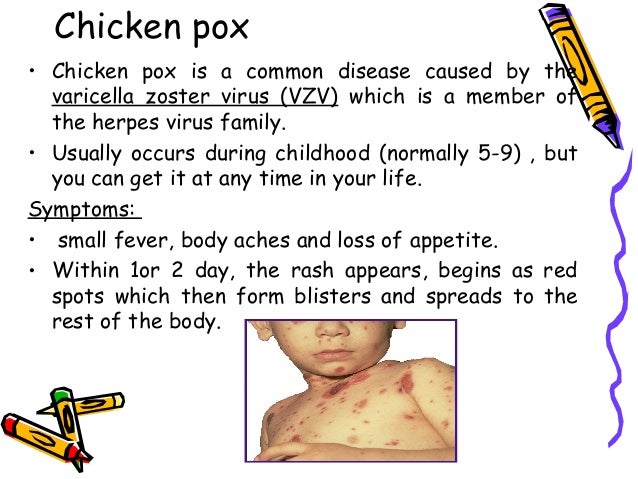What is chickenpox?
Chickenpox is a viral infection, a very common and highly contagious disease in newborns and adults may experience more severe symptoms than children who are at risk before the age of ten. Vaccinations have reduced their incidence. The symptoms of chickenpox do not appear until the infectious stage has begun these are fever, fatigue, itchy rash, loss of appetite.
We have here some very powerful home remedies for chickenpox. Chickenpox may not be a life-threatening disease It is dreaded by most because of the highly contagious nature of the infection. Chickenpox generally develops in children causing distinctive blisters, by which most of us recognize the condition. Chickenpox in infants and children is problematic mainly because of the symptoms associated with the condition.
Chickenpox infection causes severe itching and skin irritation but scratching at the blisters simply aggravates the problem, and the breakage of blisters can be even more problematic.

Chickenpox blisters, if burst or scratched at can cause severe and rather permanent chicken pox scars. The main concern for any individual would, therefore, be to minimize the itching and irritation and to resist the urge to scratch at the blisters.
Treatment for chickenpox is directed primarily at providing relief from the symptoms Rather than curing the condition. This is because of the very nature of the disease and what causes chickenpox. Chickenpox is caused by a viral infection, and treating the chickenpox virus with antibiotics would be ineffective and harmful.
Antibiotics are simply meant for the treatment of bacterial conditions but will be ineffective against viral infections. Chickenpox remedies are therefore extremely popular and constitute the first line of treatment for the condition in most parts of the world.
Home remedies for chickenpox are also popular for the treatment of the condition because of the simple reason that most of these treatments and home cures are noninvasive and also pose little to no health risks, because of the absence of any potent chemical compounds.

This virus is transmitted by air (coughing or sneezing) or physical contact with a sick person, one or two days later pimple-like eruptions appear on the body they are filled with fluid and look like blisters, then they crust over. During this period itching can be very annoying but scratching them can lead to infection and scarring.
Most of us are infected with this disease one in our lives, after the first exposure to the virus, the body builds up immunity in the form of antibodies that recognize the disease and kills the virus before it can infect us again.
Chickenpox normally starts and finishes in about two weeks, but people with weak immune systems or newborns can have very serious complications if infected prenatally there is a risk of birth defects.
Causes and symptoms

Risk Factors
Chickenpox is highly contagious and could be easily passed on through direct contact with an infected individual or through contact with contaminated objects and areas, such as through contact with fluid from chickenpox blisters, or also by being in the vicinity of an infected person when they cough or sneeze.
This may seem simple enough, but it isn’t as straightforward as it seems. The problem with controlling the spread of the chickenpox infection stems from the chickenpox incubation period.
The chickenpox incubation period in both babies and adults is characterized by an absence of symptoms Whether dealing with chickenpox symptoms in adults, infants, or kids, the symptoms and signs of infection only surface around ten days to even three weeks after the infection.
While the incubation period may be quite lengthy, the period of contagion begins a day or two before the outbreak, making this the highest risk period for contagion as there are no warning signs of infection. This period of contagion lasts so long as there are any untrusted chickenpox blisters present.
In the case of babies or infants, there is not much risk of them developing an infection in their first year if their mothers have had chickenpox in the past or were vaccinated. In such cases, the infection is usually very mild. This is because babies have a natural immunity that is passed on through antibodies from the mother’s blood.
Mothers who have never suffered from chickenpox and have not been vaccinated do have some cause for worry, however, as in such cases babies under a year of age could develop severe chickenpox.
Chickenpox symptoms in children are also likely to be a lot more severe in children who suffer from some immune system disorder or if their immunity is weakened because of some other illness or as a result of medications.
When dealing with chickenpox in infants treatment advice from your doctor should be followed meticulously. Chickenpox remedies are not just for adults and can help children and babies alike.
The remedies are primarily aimed at providing relief from the symptoms and to minimize itching and prevent scratching The biggest problem for most individuals is the aftereffect of scratching at blisters, which leaves behind scars. Chickenpox scars removal can be a lengthy and tedious treatment procedure.
Chickenpox and shingles symptoms and treatments do vary, but research indicates that individuals can greatly boost their immunity against infection through some simple diet practices.
According to a study conducted, individuals who consumed significant quantities of fruits and vegetables daily had immunity against the virus three times higher as compared to those who ate less than one serving a day.
Garlic for chickenpox
Hot or Cold Compresses for chickenpox
Licorice root
Flaxseed Oil:
Acidophilus:
Echinacea and Goldenseal:
Calamine:
Selenium:
Cat’s Claw Extract:
Effective home remedies for chickenpox
Use Catnip tea sweetened with molasses. It reduces fever. The use of brown vinegar is one of the most important among the several home remedies found beneficial in the treatment of chickenpox. Half a cup of this vinegar should be added to a bath of warm water. This will relieve the irritation of the skin.
Salt, Chillies, Ghee, oil, Spices (Masala) should not be taken at least 15 days after getting the Chickenpox symptoms. The food should be very light and easily digestible. Remember the salt will cause itching in rashes during Chickenpox so avoid using salt.
Don’t eat banana, brinjal, sweet pumpkin for someday even after the Chickenpox is completed cured. Don’t touch the rashes and if the itching is intolerable one can use neem leaves to itch. Avoid taking bath for 15 days or till the rashes are completely subsides and dries up.
Sandalwood
Applying Sandalwood oil(Sandalwood powder boiled with coconut oil and filtered) or pure Coconut oil also helps to reduce Chickenpox scars.
Make a tea with:
- 2 tbs. of the queen of the meadow.
- 1 tsp. of coltsfoot leaves.
- 2 tsp. of marigold flowers.
- 2 cups of boiling water.
In a nonmetallic pot mix, all ingredients let sit for 20 minutes. Take one cup a day. 6. Mix 2 tbs. Marigold flowers.
- 1 Tsp. witch hazel leaves.
- 1 cup of water.
- Let them sit overnight.
- Apply on the rash as needed it will relieve the itch of chickenpox.
Oatmeal Bath
A bath of oatmeal is considered a natural remedy for relieving the itch due to chickenpox. This bath is prepared by cooking two cups of oatmeal in two liters of water for fifteen minutes. This mixture is then put into a cloth bag, preferably cotton, and a string is tied tightly around the top.
This bag is allowed to float in a tub of warm water and swished around until the water becomes turbid. Precaution should be taken to ensure that the bag is not torn. The child with chickenpox can splash and play in the water, making sure that water goes over all the scales, while the pouch of oatmeal can remain in the tub. Some very useful homeopathic remedies are Antimonium crud, antimonial tartaric, Pulsatilla, sulfur, Rhus Tox.
Some herbs
Some very powerful herbs are St. John’s wort, pau d’arco, ginger, burdock root, echinacea, and goldenseal. Drink lots of water to prevent dehydration. Also, drink fresh juices. Fill the bathtub with cool water and add ginger to it, take a 30-minute bath. This helps stop the itching.
Baking soda
Baking soda is a popular remedy to control the itching in chickenpox. Some baking soda should be put in a glass of water. The child should be sponged with this water so that the soda dries on the skin. This will keep the child away from scratching the eruptions.
Useful Resource Links
- https://www.webmd.com/children/understanding-chickenpox-treatment
- https://www.uofmhealth.org/health-library/ue4861
- https://www.healthline.com/health/home-remedies-for-chickenpox
- https://kidshealth.org/en/kids/chicken-pox-itch.html
- https://www.cdc.gov/chickenpox/about/prevention-treatment.html
- https://www.medicalnewstoday.com/articles/326051.php
- https://myhealth.alberta.ca/Health/pages/conditions.aspx?hwid=ue4861
- https://www.nhs.uk/conditions/chickenpox/
- https://www.nhsinform.scot/illnesses-and-conditions/infections-and-poisoning/chickenpox

